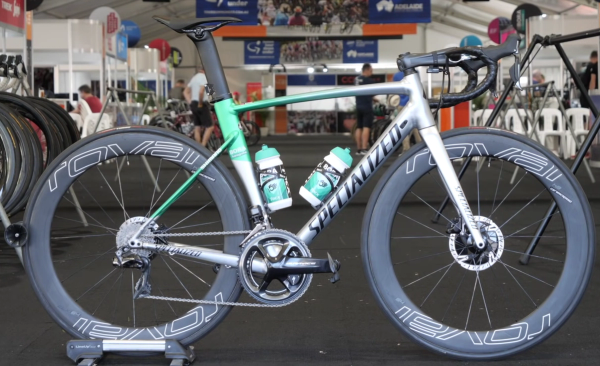Why you shouldn't set your road bike up like a pro cyclist
It’s tempting to replicate the riding position and gear choices of the pros. Here’s why it’s not a good idea
James Howell-Jones
Junior Writer
One thing’s for sure, pro bikes look cool. They’re top of the range, they’re super aero, and they always look clean and simple. As we always say: they look fast, even standing still.
Despite this, there are a lot of good reasons why you shouldn’t set your bike up like a pro. Ride with massive chainrings, tubular tyres or a ‘slammed’ stem (a stem without any spacers underneath) and you’re going to come a-cropper. Ultimately, a lot of things about how pros set up their bikes simply don’t work for the rest of us.
If any of these bike set-up traps sound familiar to you, you might need to reconsider your ride. As tempting as it might be to replicate the pros, these are all things that you should avoid when setting up your bike.
1. You’re not that flexible

© GCN
The pros love a slammed stem. For most of us, it's a bad idea
Pro riders spend a lot of time on a bike. The average pro trains for an average of 14 hours a week, and in the peak training time, they’ll spend over 20 hours in the saddle each week. Crucially, the time that they’re not on the bike is spent stretching and recovering. As a result, they can condition their bodies to put up with the kind of extreme riding positions we see in the pro peloton, with long, low stems and huge saddle to handlebar drops.
If you only jump on the bike for a few hours each week, and if you’ve got a little more weight on the top half, a slammed position is going to cause neck, shoulder and hand issues. Ultimately, any aero benefits from that ‘long and low’ position are going to be nullified by a bad fit. If you’re too hunched over, you’re not going to be able to put out the same amount of power, or ride for as long. Then there’s the handling of your bike to think about. Putting loads of weight on the front of the bike is going to ruin the handling, and unbalance the bike. Bring up the bars, and you’ll ride faster, for longer, even if your bike doesn’t look quite as cool as it would when ‘slammed’.
2. You don’t have a support car

© Velo Collection (TDW) /Getty Images
Kasper Ansgreen is saved by the team car
If a pro rider gets a puncture, they stick their hand in the air and wait for a replacement wheel. For the rest of us, we have to get out the tools and do it ourselves. As a result, we might need to tarnish the clean lines of our bike with a bag for spares and tools. A pump is essential too. It might make your bike less Instagram-worthy, but it’ll be worth it when something goes wrong out on the roads.
As self-supported riders, we’re better off leaving the tubular tyres to the pros. They might offer the absolute lowest rolling resistance possible, but they are nigh impossible to replace on the side of the road. The trusty inner tube, or the new (but still trusty) tubeless setup is a far better idea.
3. You don’t get your gear for free

© GCN
Only the best for WorldTour teams like the Ineos Grenadiers
Pro cyclists are looking to get the absolute pinnacle of performance, no matter the cost. Whenever they hit the road, they ride with the best bikes, the best wheels, the best components, the best cycling kit. Durability and practicality simply don’t come into it.
Even if we can afford the best equipment for cycling, we might think twice before using our best gear on every ride. Dirty, poor quality roads can wear down components, and there’s a risk that bikes could get damaged or stolen when stacked outside cafes when you inevitably stop for a coffee. It can be far more relaxing to use lower quality bikes and gear that are easier to maintain and cheaper to replace. For most of us, we’re really not going to notice that slight weight or aerodynamic penalty that our lower cost bikes are burdening us with.
4. You don’t need to pedal at 60kph+

© Velo Collection (TDW) /Getty Images
Sprint finish at stage 6 of the UAE Tour 2023
Pro cyclists ride really fast, partly because they’re incredibly strong, and partly because they ride in a peloton, which is aerodynamically efficient. Therefore, big gears make a lot of sense. For sprinters, a 54-tooth outer chainring is the norm, which with an 11-tooth cassette, allows pros to keep pedalling a comfortable 100rpm, even at 62kph.
For most people, the only time we find ourselves riding at 60kph plus is when we’re rolling down a hill. And at that point, you’re probably not really too fussed about pedalling. Rather than high top end speeds, most riders would benefit from easier gears with a lower range, which will make climbs easier.
5. You need mudguards (if it's wet)
You’d never see a race bike kitted out with mudguards. They add weight, and they make a bike less aerodynamic. They’re also banned by the UCI. Since we never see the best riders in the sport rocking a set of mudguards, a lot of us refuse to put them on our bikes too.
Outside of race scenarios, however, mudguards are essential for riding in wet conditions. They keep you clean, they keep your bike clean, and they keep the people riding around you clean. In fact, in training, pros often use mudguards to keep themselves and their teammates dry. They might not look pretty, but a set of mudguards is worth its weight in gold in the wetter months.











